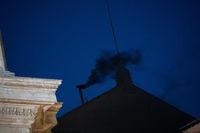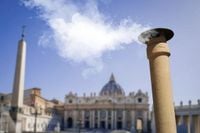The Vatican is currently in the midst of a conclave to elect the 267th Pope, following the death of Pope Francis on April 21, 2025. The conclave began on May 7, 2025, at 16:30 in the Sistine Chapel, and as of today, May 8, 2025, it is the second day of voting. The world watches closely as the results of each vote are announced through the color of smoke rising from the chimney of the chapel. Today, four votes are scheduled: two in the morning and two in the afternoon.
On the morning of May 8, the first two votes did not yield a decision, with black smoke appearing at 11:52. The next round of voting will begin at 16:30, and if a new Pope is elected during this session, white smoke may be visible around 17:30. If a second vote is required, the results will be known around 19:30.
The anticipation is palpable among the faithful gathered in St. Peter's Square, eagerly awaiting the moment when the white smoke signals the election of a new Pope. If white smoke is seen at 19:30, the new Pope is expected to appear on the balcony of St. Peter's Basilica between 20:15 and 20:45. This tradition has been observed in the past, with Pope Francis having white smoke at 19:06 and appearing at 20:12, Benedict XVI at 17:50 and appearing about 50 minutes later, and John Paul II at 18:18 with an appearance at 19:15.
The conclave this year includes a record number of 133 cardinal electors, among them four Poles: Cardinals Stanisław Ryłko, Kazimierz Nycz, Konrad Krajewski, and Grzegorz Ryś. To elect a new Pope, at least two-thirds of the votes are required, meaning 89 votes are necessary. Cardinal Giovanni Battista Re, the Dean of the College of Cardinals, expressed hope that the white smoke announcing the election would appear this evening.
As the day progresses, the excitement builds not only within the conclave but also among the crowds gathered outside, who have come to witness this historic moment. The smoke signals are not just a formality; they represent the culmination of a sacred process steeped in tradition.
But how does the Vatican produce the black and white smoke that communicates the results of the voting? Inside the Sistine Chapel, two furnaces have been temporarily installed: one for burning the ballots and another for producing smoke. Black smoke, which indicates that no Pope has been elected, is created by burning a mixture of potassium perchlorate, anthracene, and sulfur, resulting in a thick, dark plume. In contrast, white smoke, which signifies the election of a new Pope, is produced using a combination of potassium chlorate, lactose, and pine resin, yielding a bright, creamy smoke.
According to Professor Mark Lorch, head of the Department of Chemistry and Biochemistry at the University of Hull, the process is carefully controlled to ensure clarity in the smoke signals. He noted that past attempts to produce different shades of smoke often resulted in ambiguity, leading to confusion among those awaiting the announcement.
Interestingly, the tradition of white smoke as a symbol of a new Pope is relatively recent, having been established just over 100 years ago, on September 3, 1914, with the election of Pope Benedict XV. Prior to that, the results of the voting were archived without any smoke signals. The history of black smoke, however, dates back much further, serving as a long-standing indicator that a papal vacancy remains unfilled.
This year's conclave is particularly significant not only for its record number of cardinal electors but also for the global attention it has garnered. The faithful around the world are keenly aware that the choice of the next Pope will have profound implications for the Catholic Church and its direction in the years to come.
As the cardinals return to the Sistine Chapel for the afternoon votes, the atmosphere is charged with anticipation. The next few hours could change the course of history for the Catholic Church, with many eyes on the chimney of the chapel, waiting for that telltale sign of white smoke.
Should white smoke emerge today, it will not only mark the election of a new Pope but also the beginning of a new chapter for the Church, one that many hope will continue the reforms initiated by Pope Francis. Among the favorites for the papacy are Cardinal Pietro Parolin from Italy, Luis Antonio Tagle from the Philippines, and Mario Grech from Malta, who is seen as a potential dark horse candidate.
The conclave process is steeped in tradition and secrecy, with cardinal electors required to take an oath of confidentiality, ensuring that the discussions and voting outcomes remain private until the official announcement is made. This commitment to secrecy adds an air of mystery to the proceedings, heightening the anticipation surrounding the eventual announcement of the new Pope.
As the sun sets over Vatican City, the world waits with bated breath for the smoke signals that will announce the new leader of the Catholic Church. Will the faithful hear the words "Habemus Papam" tonight, or will they have to wait for another day? Only time will tell as the conclave continues its sacred deliberations.


![Konklawe na żywo [TRANSMISJA]](https://thumbor.evrimagaci.org/_yzHtKx-NZ_OQ-98Jt1_TEIpgXs=/200x0/tpg%2Fsources%2F976eacda-5a09-433c-a8e3-b44afeee9711.jpeg)
